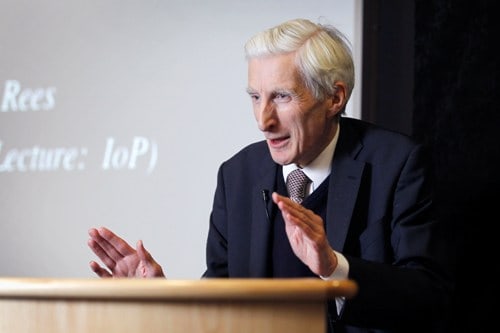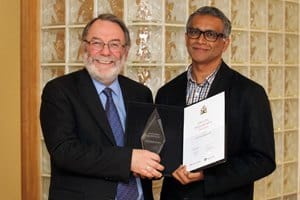By Matin Durrani

I travelled to London last night to hear the celebrated astronomer Martin Rees give an entertaining and thought-provoking lecture to more than 100 people at the Institute of Physics as the winner of the 2012 Isaac Newton medal – the Institute’s top award.
Having written more than 500 papers on everything from black holes and gamma-ray bursts to quasars and the dynamics of gas clouds, Rees’s bulging CV also includes spells as president of both the Royal Society and of the Royal Astronomical Society, which I guess makes him a worthy winner of the prize. (I should add that although the Institute publishes Physics World, I was not involved in selecting Rees for the award.)
In a lecture entitled “From Mars to the multiverse”, Rees, 70, said that the fields of astronomy, astrophysics and cosmology were as exhilarating now for young researchers as they were when he first started out as a fresh-faced scientist back in the 1960s.
He then recalled various successful missions to the planets in our solar system over the last 50 years, including the Curiosity rover currently exploring Mars, before discussing the search for extrasolar planets, the physics of galaxy collisions and the prerequisites for a complex cosmos.
In the final part of the lecture, Rees touched on what he called “speculative physics”, such as the existence of a multiverse and the possibility that we live in a “vast cosmic archipelago”. Underlining the fact that much of the work on these topics is speculation, Rees nevertheless insisted it was “physics not metaphysics”.
One mind-bending notion he discussed is the possibility that – because the expansion of the universe is accelerating – some of the galaxies we see now will eventually go beyond our cosmic horizon, never to be seen again. It’s the kind of thing that could keep you awake at night if you thought about it too much.

receiving his prize from
Peter Knight. (Courtesy:
Helen Yates Photography)
After the lecture, I went downstairs to the drinks reception, where Peter Knight, president of the Institute of Physics, presented the inaugural Physics Journalism Prize to Anil Ananthaswamy. Sponsored by the Institute and the Science and Technology Facilities Council, the prize is “designed to inspire the next generation of physicists by encouraging journalists to grapple with often complex topics and help spread excitement about the subject”.
Ananthaswamy won the prize for the brilliantly titled article “Hip, hip array” in New Scientist about the Square Kilometre Array – a massive radio telescope consisting of more than 3000 dishes to be built in southern Africa and Australia. The prize will see Ananthaswamy visiting various physics facilities in Japan and he will be writing an article for Physics World about some aspect of the trip.
We’re in good hands, as Ananthaswamy wrote the great book The Edge of Physics, in which he ventured to a series of labs around the world: from Lake Baikal to the Antarctic. We picked it as our Book of the Year in 2010 and you can hear about his exploits in this online lecture he gave for us in 2011.
[brightcove videoID=phw.live/2010-02-11-lord-rees/1 playerID=106573614001 height=344 width=500]
In the meantime, do check out this video interview I did with Rees in 2010, when he was just nearing the end of his term as president of the Royal Society. The interview took place in the society’s palatial “presidential flat”.



